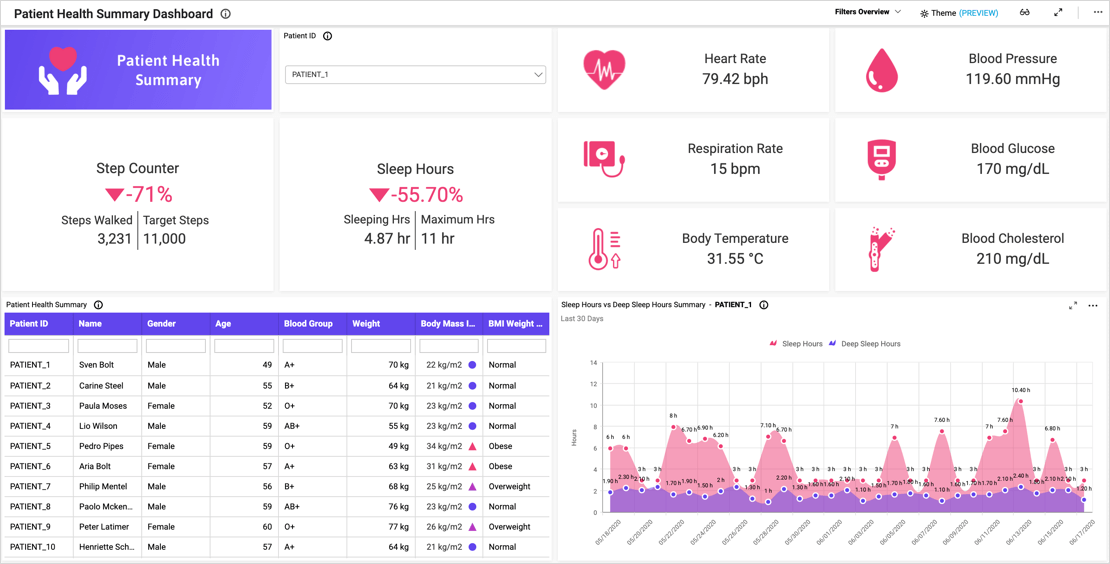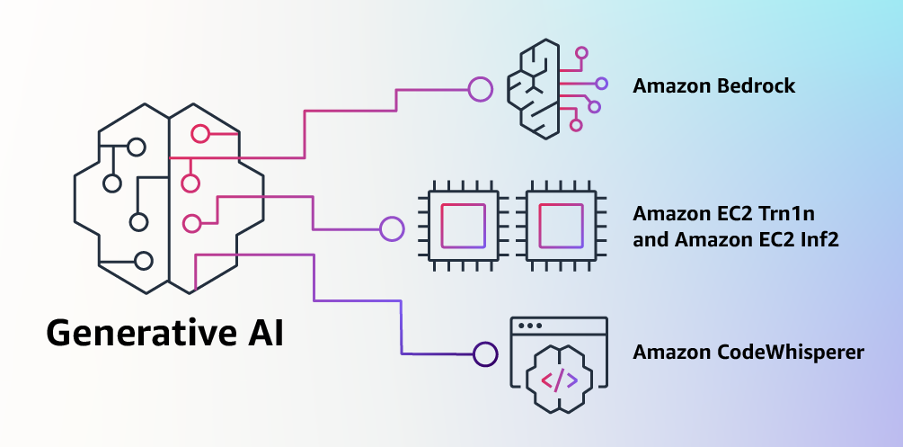- Home
- About
- Consulting
- Services
- Minfy Labs
- Industries
- Resonances
- Careers
- Contact

In the fast-paced landscape of healthcare, technology has emerged as a catalyst, propelling us into a new era of transformative change. It has revolutionized the way we improve efficiency and elevate patient outcomes, creating a ripple effect across the industry [1]. As I delved into the dynamic world of healthcare client partnerships, an intriguing trend caught my attention. A multitude of clients, driven by favorable government policies and a recognition of the immense potential, are venturing into the realm of innovation. With open arms, they are welcoming the convergence of Artificial Intelligence and Machine Learning (AIML) into their daily operations, forging a path toward remarkable breakthroughs.
This transformative shift is not a mere theory; it brings tangible advantages that industry experts have confirmed. In a report by McKinsey, it was revealed that organizations leveraging the power of data and embracing a data-driven approach are 23 times more likely to surpass their competitors in acquiring customers. Not only that, they are nine times more likely to retain customers and can achieve up to 19 times higher profitability. These statistics serve as an emphatic reminder of the undeniable edge gained by adopting data-driven strategies.
Recently, I had the privilege of collaborating with two visionary clients from the healthcare industry who were at the forefront of this transformative movement. Both organizations were fervently pursuing operational efficiency and harnessing the power of data analysis to unlock profound insights.
These clients, like many other healthcare organizations, found themselves immersed in an ocean of data, yearning for a solution that would enable them to derive comprehensive and refined treatment options, empowering their patients with optimal care. Enter Smart Health Reports — a combination of data analytics, artificial intelligence, and automation. This seminal approach empowers healthcare professionals with swift and thoughtful decision-making capabilities, propelling them toward delivering the highest standards of care. Join me in this article as we delve into the elaborateness of Smart Health Reports, exploring their potential, and unraveling the complications of implementing them within the dynamic healthcare ecosystem.
Smart Health Reports refer to a digital system that integrates data analytics, AI, and automation to generate comprehensive insights and information about individual patients or larger population health trends. These reports aim to streamline healthcare processes, improve efficiency, and enhance patient outcomes[2].

Smart Health Reports typically consist of the following components:
Data Collection: Smart Health Reports, which are positioned to impact the landscape of healthcare, depend upon data collection. These reports capitalize on the power of data analytics, artificial intelligence (AI), and automation. These reports provide a holistic view of an individual’s health or discover significant insights into broader health patterns by tapping into varied data sources such as electronic health records, medical devices, wearables, and patient-generated data.
Data Analytics: Beginning with the collecting of information from diverse sources, data analytics is a critical component of the healthcare system. Once collected, this data is subjected to advanced analytical techniques in order to reveal patterns, trends, and correlations. The resulting analysis provides healthcare practitioners with the knowledge they need to make informed decisions and develop personalized treatment plans. The healthcare industry is now able to optimize patient care and drive better health outcomes because of the power of data analytics[3].
Artificial Intelligence (AI): Artificial intelligence algorithms and machine learning models are integral components of Smart Health Reports. These technologies extract valuable insights from the data, enabling predictive analytics, risk assessment, and personalized healthcare recommendations. By utilizing AI, healthcare professionals can enhance their understanding of individual patients and proactively address potential health risks.
Automation: Automation plays a critical role in Smart Health Reports, providing a necessary value to their functionality. This feature allows for real-time reporting, automated alarms, and seamless connectivity with other healthcare systems, resulting in streamlined and efficient processes. Healthcare personnel can save time, reduce the risk of human mistakes, and assure the timely delivery of critical information by automating numerous operations. This feature emphasizes the transformative power of automation in improving healthcare practices.
The seamless integration of these components unlocks a powerful tool that provides healthcare professionals with timely and actionable information. This transformative capability goes beyond serving a specific audience, as Smart Health Reports cater to a diverse range of stakeholders, including doctors, nurses, researchers, policymakers, and even patients themselves.
Smart Health Reports bring a multitude of benefits that significantly enhance healthcare efficiency and patient outcomes. These reports empower healthcare professionals by providing valuable insights and streamlining decision-making processes through the utilization of data analytics, artificial intelligence, and automation. Let’s delve into the compelling features and capabilities of Smart Health Reports:
Real-time Data Collection and Analysis: Smart Health Reports employ advanced data collection methods, including integration with electronic health records (EHRs), medical devices, and wearable technology. This ensures the continuous capture of up-to-the-minute patient data, encompassing vital signs, laboratory results, and medical history. Through cutting-edge data analytics techniques, the reports process and analyze this information in near real-time, furnishing healthcare professionals with the latest actionable insights.
Predictive Analytics for Proactive Healthcare: Harnessing the power of AI and machine learning algorithms, Smart Health Reports have the ability to predict health outcomes and identify potential risks for individual patients. By analyzing historical patient data alongside relevant population health information, these reports detect patterns, trends, and risk factors. This proactive approach empowers healthcare professionals to intervene early, preventing or managing chronic conditions, reducing hospital readmissions, and ultimately enhancing overall patient well-being.
Customizable and User-friendly Interfaces: User experience lies at the heart of Smart Health Reports. These reports offer customizable interfaces, enabling healthcare professionals to personalize the data presentation to align with their preferences and workflow requirements. With intuitive and user-friendly dashboards, graphs, and visualizations, the reports facilitate swift interpretation and seamless navigation through complex datasets. This exceptional usability empowers efficient decision-making processes.
Decision Support Tools: Smart Health Reports often incorporate decision-support tools that provide evidence-based recommendations and guidelines to healthcare professionals. Drawing on a wealth of data and knowledge, these tools suggest appropriate diagnostic tests, treatment options, and medication recommendations tailored to patient-specific characteristics and best practices. This invaluable feature supports healthcare professionals in making informed decisions, reducing errors, and enhancing treatment outcomes.
Integration and Interoperability: Seamless integration with existing healthcare systems, such as EHRs, laboratory information systems, and telehealth platforms, is a hallmark of Smart Health Reports. This integration facilitates data and information exchange across diverse healthcare settings and providers, fostering care coordination and collaboration. Interoperability guarantees that healthcare professionals have access to a comprehensive patient overview, leading to well-informed decisions and improved continuity of care[4].
By embracing Smart Health Reports, healthcare professionals gain the tools and insights needed to revolutionize patient care. These reports optimize efficiency, enable proactive healthcare interventions, and facilitate seamless collaboration. Whether you are a healthcare provider, administrator, researcher, or patient, Smart Health Reports have the potential to drive positive change, improve health outcomes, and elevate the overall healthcare experience. Embrace this transformative technology and unlock a new era of healthcare excellence.
Implementing Smart Health Reports in healthcare settings comes with its own set of challenges and considerations. While these reports offer tremendous potential for improving healthcare efficiency, there are several factors that need to be addressed for successful integration within the healthcare ecosystem. Let’s explore some of the key implementation challenges and considerations:
Data Privacy and Security: In the realm of healthcare, safeguarding patient data holds the utmost significance. The integration of Smart Health Reports necessitates strict adherence to data privacy regulations, including the Health Insurance Portability and Accountability Act (HIPAA) in the United States and the proposed Digital Information Security in Healthcare Act (DISHA) in India. It is imperative for healthcare organizations to establish robust security measures to protect sensitive patient information from unauthorized access, breaches, and potential cyber threats. By prioritizing data security, healthcare entities can ensure the confidentiality and integrity of patient data, instilling trust and confidence in the healthcare ecosystem.
Interoperability and Integration: The integration of Smart Health Reports into existing healthcare systems can present complexities. Healthcare organizations frequently operate multiple systems, including electronic health records (EHRs), laboratory information systems, and imaging systems, which may not have seamless communication capabilities. Ensuring interoperability demands meticulous planning, collaborative efforts, and adherence to data standards. These measures are crucial to facilitate the smooth exchange of information across diverse platforms and providers, ultimately enhancing the overall functionality and effectiveness of healthcare systems.
Adoption and Training: The successful implementation of Smart Health Reports relies on healthcare professionals embracing and effectively utilizing these new technologies. Resistance to change and a lack of familiarity with the new system can hinder adoption. Healthcare organizations should provide comprehensive training programs to educate healthcare professionals on the benefits and functionalities of Smart Health Reports. User experience and user interface design should also be prioritized to ensure ease of use and minimize learning curves.
Cost and Infrastructure: Implementing Smart Health Reports requires healthcare organizations to carefully consider the financial aspects, as it may involve investments in software, hardware, and infrastructure upgrades. These organizations need to assess the potential return on investment (ROI) of such implementations. It is essential to evaluate the financial implications and weigh them against the expected benefits. Additionally, ensuring the availability of adequate IT infrastructure is crucial. This includes reliable networks to support seamless data exchange and secure data storage capabilities to handle the vast volumes of healthcare data generated by Smart Health Reports. Striking the right balance between financial considerations and the necessary technological infrastructure is key to successfully implementing these reports within healthcare organizations.
Ethical and Legal Considerations: The use of advanced technologies in healthcare raises ethical and legal considerations. Ethical dilemmas may arise when using AI algorithms for decision-making or when determining the scope of AI-driven automation in patient care. Healthcare organizations need to ensure that ethical frameworks and legal guidelines are established to govern the use of Smart Health Reports, maintaining a balance between technology-driven efficiency and patient-centric care [5].
Patient Engagement and Trust: Successfully implementing Smart Health Reports involves engaging and educating patients about the benefits and implications of these systems. Patients should be informed about how their data will be collected, stored, and used, ensuring transparency and obtaining their consent. Building trust with patients through effective communication can contribute to their acceptance and active participation in their own healthcare journey [6].
We are at a critical juncture in the dynamic world of smart healthcare. While fundamental principles and systems have been developed, the introduction of new technologies and problems opens up a wide range of opportunities for growth and advancement. It is now up to us to rise to the occasion and face these challenges with determination and resolution.
In this pursuit, collaboration becomes our greatest ally. We must join forces, bringing together healthcare organizations, technology providers, policymakers, and regulatory bodies, to confront the implementation challenges that lie ahead. By uniting our expertise, we have the power to unlock a future of enhanced efficiency, elevated patient care, and ultimately, better health outcomes within our healthcare systems.
The adoption of technological developments such as Smart Health Reports has moved from voluntary to mandatory in a fast-expanding healthcare market. It is the path that will allow us to provide efficient, patient-centered care, ultimately leading to better health outcomes for everyone. As a result, it is critical that we work together, push the boundaries, and truly embrace the transformative force of innovation as we journey towards a future where healthcare’s potential is limitless.
[1] https://www.sciencedirect.com/science/article/pii/S2414644719300508
Tian, S., Yang, W., Grange, J.M.L., Wang, P., Huang, W. and Ye, Z. (2019). Smart healthcare: making medical care more intelligent. Global Health Journal, [online] 3(3), pp.62–65. doi:https://doi.org/10.1016/j.glohj.2019.07.001.
[2] Doke, G. (2020). Enable Patients to Understand their Health with Medical Smart Reports. [online] CrelioHealth For Diagnostics. Available at: https://blog.creliohealth.com/enable-patients-to-understand-their-health-with-smart-reports/[Accessed 1 Jun. 2023].
[3] Cote, C. (2021). 3 Applications of Data Analytics in Healthcare. [online] Business Insights — Blog. Available at:https://online.hbs.edu/blog/post/data-analytics-in-healthcare.
[4] Cote, C. (2021). What Is Data Integrity and Why Does It Matter? [online] Business Insights — Blog. Available at:https://online.hbs.edu/blog/post/what-is-data-integrity.
[5] Farhud, D.D. and Zokaei, S. (2021). Ethical Issues of Artificial Intelligence in Medicine and Healthcare. Iranian Journal of Public Health, 50(11). doi:https://doi.org/10.18502/ijph.v50i11.7600.
[6] Mercer, S.W. (2004). The consultation and relational empathy (CARE) measure: development and preliminary validation and reliability of an empathy-based consultation process measure. Family Practice, 21(6), pp.699–705. doi:https://doi.org/10.1093/fampra/cmh621.
Generative AI, a form of artificial intelligence, has the ability to produce fresh content and concepts such as discussions, narratives, visuals, videos, and music. It relies on extensive pre-training of large models known as foundation models (FMs) using vast amounts of data.
AWS offers generative AI capabilities that empower you to revolutionize your applications, create entirely novel customer experiences, enhance productivity significantly, and drive transformative changes in your business. You have the flexibility to select from a variety of popular FMs or leverage AWS services that integrate generative AI seamlessly, all supported by cost-effective cloud infrastructure designed specifically for generative AI.
Unlike traditional ML models that require gathering labelled data, training multiple models, and deploying them for each specific task, foundation models offer a more efficient approach. With foundation models, there's no need to collect labelled data for every task or train numerous models. Instead, you can utilize the same pre-trained foundation model and adapt it to different tasks.
FM models possess an extensive array of parameters, enabling them to handle a diverse range of tasks and grasp intricate concepts. Moreover, their pre-training involves exposure to vast amounts of internet data, allowing them to acquire a profound understanding of numerous patterns and effectively apply their knowledge across various contexts.

Additionally, foundation models can be customized to perform domain-specific functions that provide unique advantages to your business. This customization process requires only a small portion of the data and computational resources typically needed to train a model from scratch. Customized FMs can make each customer's experience special by representing the company's personality, manner, and offerings in different fields like banking, travel, and healthcare.
Amazon CodeWhisperer is an AI coding companion that incorporates generative AI capabilities to enhance productivity. Furthermore, AWS offers sample solutions that combine their AI services with prominent Foundation Models to facilitate the deployment of popular generative AI use cases like call summarization and question answering.
Achieve optimal price-performance ratio for generative AI by utilizing infrastructure powered by AWS-designed ML chips and NVIDIA GPUs. Efficiently scale your infrastructure to train and deploy Foundation Models with hundreds of billions of parameters while maintaining cost-effectiveness.
AWS offers powerful instances, such as GPU-equipped EC2 instances, that can accelerate the training process. These instances are optimized for machine learning workloads and provide the necessary computational resources to train large language models efficiently.
Consider a variety of FMs offered by AI21 Labs, Anthropic, Stability AI, and Amazon to discover the most suitable model for your specific use case.
Easily tailor FMs for your business using a small set of labelled examples. Rest assured that your data stays secure and confidential as it is encrypted and never leaves your Amazon Virtual Private Cloud (VPC).
Effortlessly incorporate and implement FMs into your applications and workloads on AWS by leveraging the familiar controls and seamless integration with AWS's extensive range of capabilities and services, such as Amazon SageMaker, Jumpstart and Amazon S3.
Amazon Bedrock is a service that helps you access and use AI models created by top AI start-ups and Amazon. It provides an easy way to choose from a variety of models that are suitable for your specific needs. With Bedrock, you can quickly start using these models without worrying about managing servers or infrastructure.
You can also customize the models with your own data, and seamlessly integrate them into your applications using familiar AWS tools like Amazon SageMaker. Bedrock makes it easy to test different models and manage your AI models efficiently at a large scale.
We can select one FM from AI21 Labs, Anthropic, Stability AI, and Amazon to identify the most suitable FM for our specific needs.
Text Generation
Chatbot
Image Generation
Text summarization
Search
Personalization
CodeWhisperer leverages the power of state-of-the-art language models, such as GPT-3.5, to provide intelligent suggestions and solutions tailored to your coding needs. From syntax and code structure suggestions to algorithm optimizations and design patterns, CodeWhisperer analyses your code and offers valuable insights to help you write cleaner, more efficient code.
CodeWhisperer is an advanced AI model that has been extensively trained on an immense line of code, enabling it to swiftly provide code suggestions. These suggestions can range from small code snippets to complete functions, and they are generated in real time based on your comments and existing code. By leveraging CodeWhisperer, you can bypass time-consuming coding tasks and expedite the process of working with unfamiliar APIs.

It has the capability to identify and categorize code suggestions that closely resemble open-source training data. This feature enables the retrieval of the respective open-source project's repository URL and license information, facilitating convenient review and attribution.
Check your code for hidden security flaws that are difficult to detect. Receive suggestions on how to fix these issues right away. Follow the recommended security guidelines from organizations like OWASP and adhere to best practices for handling vulnerabilities, including those related to cryptographic libraries and other security measures.
Amazon has been focused on artificial intelligence (AI) and machine learning (ML) for more than 20 years. ML plays a significant role in many of the features and services that Amazon offers to its customers. There are thousands of engineers at Amazon who are dedicated to ML, and it is an important part of Amazon's history, values, and future. Amazon Titan models are created using Amazon's extensive experience in ML, with the goal of making ML accessible to everyone who wants to use it.
Amazon Titan FMs are highly capable models that have been pretrained on extensive datasets, enabling them to excel in various tasks. They can be utilized as they are or privately fine-tuned with your own data, eliminating the need to manually annotate significant amounts of data for a specific task.
Automate natural language tasks such as summarization and text generation
Titan Text is a generative large language model designed to perform tasks like summarization, text generation (such as creating blog posts), classification, open-ended question answering, and information extraction.
Enhance search accuracy and improve personalized recommendations
Titan Embeddings is an LLM that converts text inputs, such as words, phrases, or even longer sections of text, into numerical representations called embeddings. These embeddings capture the semantic meaning of the text. Although Titan Embeddings does not generate text itself, it offers value in applications such as personalization and search. By comparing embeddings, the model can provide responses that are more relevant and contextual compared to simple word matching.
Support responsible use of AI by reducing inappropriate or harmful content
Titan FMs are designed to identify and eliminate harmful content within data, decline inappropriate content within user input, and screen model outputs that may include inappropriate elements like hate speech, profanity, or violence.
Amazon SageMaker JumpStart provides pre-trained, open-source models for a wide range of problem types to help you get started with ML. You can incrementally train and tune these models before deployment. JumpStart also provides solution templates that set up infrastructure for common use cases, and executable example notebooks for ML with Amazon SageMaker.
Amazon SageMaker JumpStart is a valuable resource designed to speed up your machine learning endeavours. It serves as a hub where you can gain access to pre-trained models and foundational models available in the Foundations Model Hub.
These models enable you to carry out various tasks such as article summarization and image generation. The pre-trained models are highly adaptable to suit your specific use cases and can be seamlessly deployed in production using either the user interface or the software development kit (SDK).
It's worth noting that none of your data is utilized in the training of the underlying models. Your data is securely encrypted and remains within the virtual private cloud (VPC), ensuring utmost privacy and confidentiality.
Jumpstart GPT-2 model, facilitates the generation of text resembling human language by leveraging a given prompt. This transformative model proves valuable in automating the writing process and generating fresh sentences. Its applications range from creating content for blogs and social media posts to crafting books.
Belonging to the Generative Pre-Trained Transformer series, GPT-2 served as the precursor to GPT-3. However, the OpenAI ChatGPT application currently relies on the GPT-3 model as its foundation.
AWS Trainium is a specialized machine learning (ML) accelerator developed by AWS for training deep learning models with over 100 billion parameters. Each Amazon Elastic Compute Cloud (EC2) Trn1 instance is equipped with up to 16 AWS Trainium accelerators, providing a cost-effective and high-performance solution for cloud-based deep learning training.
While the adoption of deep learning is growing rapidly, many development teams face budget constraints that limit the extent and frequency of training required to enhance their models and applications. EC2 Trn1 instances powered by Trainium address this challenge by enabling faster training times and delivering up to 50% cost savings compared to similar Amazon EC2 instances.
Trainium has been specifically designed for training natural language processing, computer vision, and recommender models that find applications in a wide range of areas, including text summarization, code generation, question answering, image and video generation, recommendation systems, and fraud detection.
Currently, a significant amount of time and resources are dedicated to training FMs (machine learning models) because most customers are just beginning to implement them in practical applications
However, as FMs become widely deployed in the future, the majority of expenses will be associated with running the models and performing inferences. Unlike training, which occurs periodically, a production system continuously generates predictions or inferences, potentially reaching millions per hour
These inferences must be processed in real-time, necessitating low-latency and high-throughput networking capabilities. A prime example of this is Alexa, which receives millions of requests every minute and contributes to 40% of total compute costs
Amazon recognized the significant impact that running inferences would have on the costs of machine learning in the future. As a result, they made it a priority to invest in chips optimized for inference several years ago
In 2018, they introduced Inferentia, the first specialized chip designed specifically for inference tasks. Inferentia has been instrumental in enabling Amazon to perform trillions of inferences each year, resulting in substantial savings of over a hundred million dollars in capital expenses for companies like Amazon
The achievements that have been witnessed so far are remarkable, and foresee numerous opportunities to continue our innovation efforts, particularly as workloads become larger and more complex with the integration of generative AI into various applications
AWS is currently engaged in the exploration of methods to empower customers in utilizing the LLM’s effectively, enabling them to offer distinctive and exceptional experiences to their own customers while keeping the required effort to a minimum. The goal is to establish a system where customers can make use of foundational models created by AWS partners like Anthropic, Stability AI, and Hugging Face, thereby delivering value to the market.
AWS aims to provide customers with the tools and support necessary to create personalized Generative AI solutions tailored to their individual needs and preferences.
References
https://aws.amazon.com/generative-ai/
https://aws.amazon.com/bedrock/
https://aws.amazon.com/machine-learning/trainium/
https://aws.amazon.com/blogs/machine-learning/deploy-generative-ai-models-from-amazon-sagemaker-jumpstart-using-the-aws-cdk/
https://aws.amazon.com/blogs/machine-learning/build-a-serverless-meeting-summarization-backend-with-large-language-models-on-amazon-sagemaker-jumpstart/
© 2022 Minfy™. Minfy Technologies. All rights reserved. | Privacy Policy | Terms and Conditions
This website stores cookie on your computer. These cookies are used to collect information about how you interact with our website and allow us to remember you. We use this information in order to improve and customize your browsing experience and for analytics and metrics about our visitors both on this website and other media. To find out more about the cookies we use, see our Privacy Policy. If you decline, your information won’t be tracked when you visit this website. A single cookie will be used in your browser to remember your preference not to be tracked.
 Go to Swayam
Go to Swayam